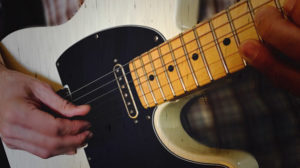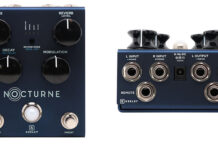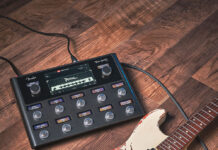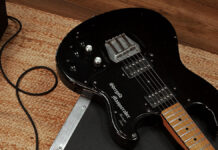
An Introduction to the Tritone Scale
While mixolydian, diminished, Lydian dominant and the altered scale are all fairly common choices when playing over 7th chords in various situations, there is one scale that is often overlooked, but that can add a freshness to your lines and take your playing in new directions at the same time.
Guitarists who’ve starting exploring the different possibilities for soloing over dominant 7th chords have probably quickly realized there are a lot of different scales and modes you can use to bring color to this common chord in your solos.
While mixolydian, diminished, Lydian dominant and the altered scale are all fairly common choices when playing over 7th chords in various situations, there is one scale that is often overlooked, but that can add a freshness to your lines and take your playing in new directions at the same time.
This is the tritone scale.
Built by pairing two major triads a tritone apart, and then placing those notes in scale order, the tritone scale brings a nice level of tension to your lines that you can use to build energy when soloing over 7th chords in a jazz or fusion context.
Let’s explore this scale as we check out a short introduction to the tritone scale, its construction, how to use it and some basic fingerings for this scale on the guitar.
What is the Tritone Scale?
To begin our exploration of this uncommon but cool-sounding scale, let’s look at how the scale is built. Basically, the tritone scale is built by taking the notes of a 7b9#11 chord and turning it into a scale. Here’s what I mean on paper. Then we’ll dig deeper after you’ve had an initial look at this comparison over a C tritone scale.

As you can see, the C7b9#11 chord has the notes C E F#(Gb) Bb and Db. There is also a G in this chord, but we don’t usually have enough fingers to play it, so it gets left out.
In the second bar of the example, you can see these notes divided into two major triads, one from the root and one from the tritone note (Gb in this case).
These are the notes of the C7b9#11 chord, C E G + Gb Bb Db, and when placed in note order, C Db E Gb G Bb, they become the C Tritone Scale, as shown in the third bar of the example.
Because of this relationship, between the tritone scale and the 7b9#11 chord, the tritone scale is often used over a 7alt chord to produce the b9 and #11 alterations, or over a dominant 7th chord where you want to create tension you can later resolve over the same chord, or over the next chord in the progression.
The tritone scale has the intervals, Root-b2-3-b5-5-b7, so all of those juicy notes we saw in the C7b9#11 chord in the first bar of the example. Now that you know how to build a tritone scale, R-b2-3-b5-5-b7, let’s take a look at a few common fingerings for this scale on the guitar.
Tritone Scale Fingerings
There are a number of ways to play the tritone scale on the guitar, but here are two of my favorites.
Check out these fingerings, one off of the sixth string and one from the fifth-string root, and see how they lay under your fingers and if they sit comfortably for you as well.

Once you’ve learned these two fingerings in the key of C, take them to all of the other 11 keys around the neck to build a full understanding of these scale shapes across the entire fretboard.
If you feel ready, you also can put on a 7b9#11 or 7th-chord vamp and practice using the tritone scale to solo over those chord changes before bringing it to ii V I chord changes as well as tunes you’re working on, or already know, in the practice room.
Tritone Scale Licks
To help get you started with the tritone scale, here’s a fun little lick I came up with using the C tritone scale over the C7 chord in this ii-V-I-vi chord progression in F major.
Learn the lick and work it in a few keys around the neck, and at different tempos if possible. Then try coming up with a few tritone scale licks of your own to add to your jazz-guitar soloing vocabulary.

Practicing the Tritone Scale
In order to further your exploration and understanding of the tritone scale, here are five exercises I like to do with this scale, and you can add them to your practice routine this week.
01. Sing the note C and play the tritone scale from that root. Repeat in 12 keys.
02. Play a C7b9#11 chord and sing the tritone scale from that root. Repeat in 12 keys.
03. Jam on a C7 vamp using only the C tritone scale to build your solo lines. Repeat in 12 keys.
04. Play a ii V I in the key of C major and use the tritone scale to build your solo lines over the V7 chord in that progression. Repeat in 12 keys
05. Put on a blues backing track and solo over each 7th chord using the tritone scale to build your lines and phrases.
Though it is not a commonly used scale, the tritone scale is worth exploring in your practice routine as it can add a welcome freshness to any 7th-chord soloing line, taking your jazz-guitar playing in new directions at the same time.
What do you think of this scale? Share your thoughts!
Matt Warnock is the owner of mattwarnockguitar.com, a free website that provides hundreds of lessons and resources designed to help guitarists of all experience levels meet their practice and performance goals. Matt lives in the UK, where he is a senior lecturer at the Leeds College of Music and an examiner for the London College of Music (Registry of Guitar Tutors).
Source: www.guitarworld.com











